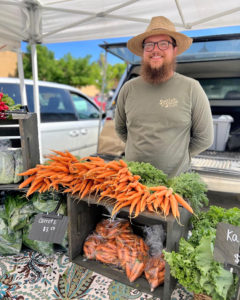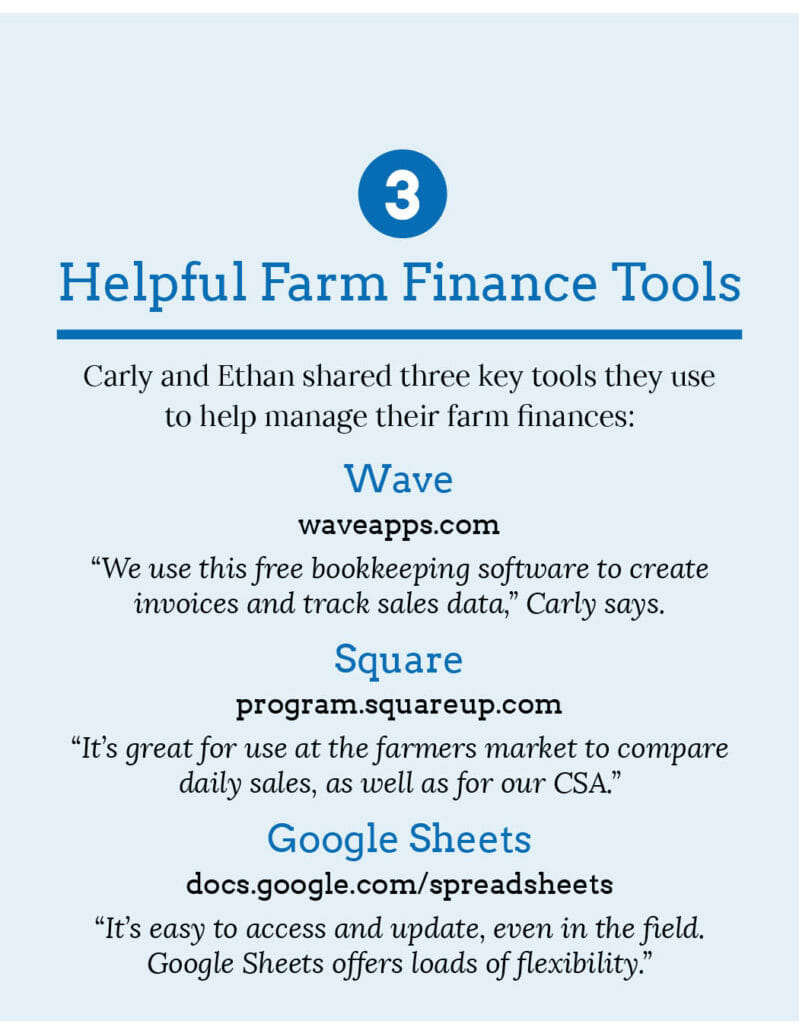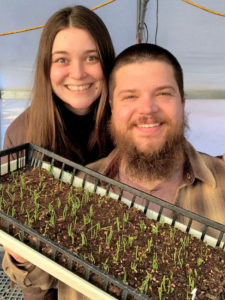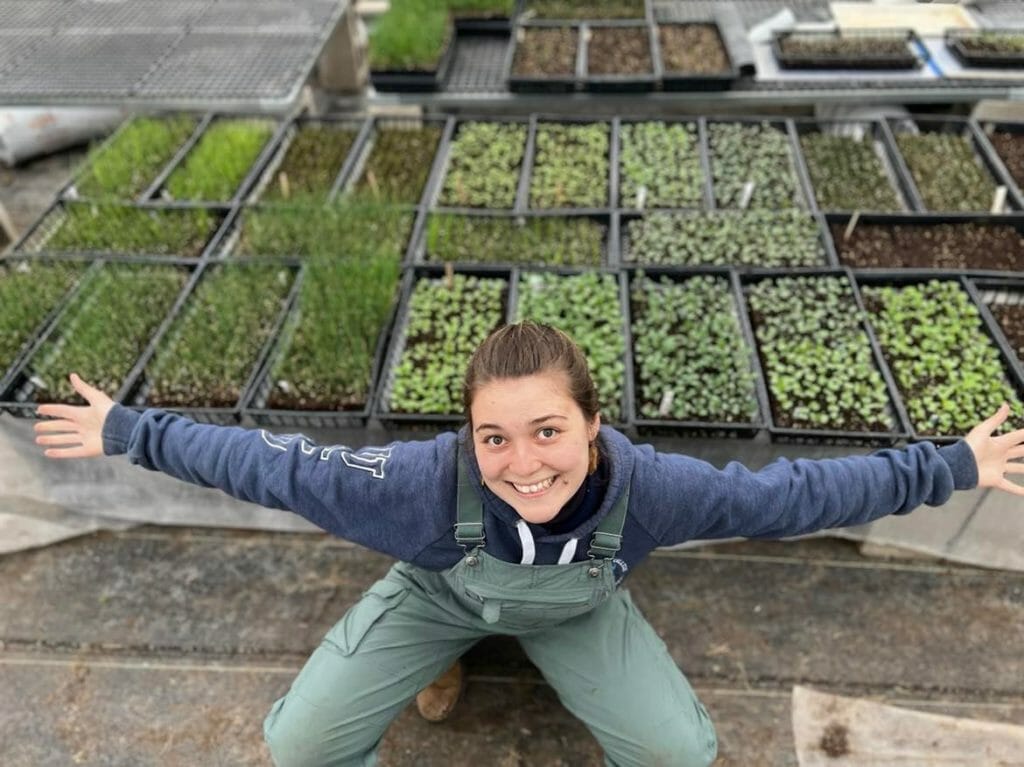Doing the Math to Grow a Farm
“This is the kind of math you need to know to farm?!” Carly Zierke asked herself as she sat through her first farm finance course at the Organic Farm School in Clinton, Washington, in 2021. The instructor was showing the class of beginning vegetable farmers, which included Carly and her husband Ethan, what an actual farm cash flow looked like.
“We were looking at the numbers farmers use to understand the amount and cost of water during a drought to pay for the seeds they need to start,” Carly says. On that first day, those numbers appeared indecipherable to her.
Now, several steps into their farming journey, Carly and Ethan know enough to recognize the answer. “Calculating the cost of water to buy for your seeds to start? Yes,” Carly says. “That’s exactly the kind of math you need to know.” This realization may have been among the first for these first-generation farmers, but it was far from the last.
From Curious to Driven
Carly and Ethan grow produce for a CSA and local markets at Sweet Season Farm, near Decorah, Iowa. In March, Carly also joined the PFI staff as the new digital content coordinator, a position she’ll hold while continuing to farm. In 2019, she and Ethan first started thinking about farming for two key reasons: a concern for the environment and a desire to get closer to how their food was grown.
“It started with curiosity and led to a drive to keep learning about it,” Ethan says. “We got our first farming jobs at Echollective Farm near Iowa City in the early pandemic days.”

Ethan describes the evolution of their perspective. “We saw just how important the local food system was for so many people [due to] supply chain issues. A more resilient local food system was necessary, and we wanted to be part of the solution.” As their farm dreams started to take shape, it was clear they had a lot to learn. Though they both grew up in Iowa – Carly in Marquette and Ethan in Iowa City – neither came from a farming background.
Not only did they lack access to land and capital, they also needed to develop a fuller understanding of production techniques and business management. A connection in their farming network illuminated a path forward for them. “Corbin Scholtz is a close friend who also farmed in the Iowa City area,” Carly says. “She introduced us to the Organic Farm School, which we attended in 2021.”
The Organic Farm School is a nonprofit whose mission focuses on “training new farmers to develop and manage small farms focused on ecological, economic and social regeneration.” The organization also helps participants learn about their role in local and regional food systems. “There, we learned about both the growing side of things as well as the business end, such as cash flow and how to apply for loans through the USDA’s Farm Service Agency,” Carly says.
“It seems hard to learn,” Ethan says. “But in reality, it’s essential to be able to forecast what finances are going to look like for the future on your farm.”
Gaining Land and Insight
As the Zierkes were working to fill their farming knowledge gap, a connection they made within their network helped them address the land access problem. Barb Kraus has been raising organic fruit, vegetables and flowers for 25 years at Canoe Creek Produce near Decorah. She also provides land access to beginning farmers through an incubator farm program she runs on her land. “I met with Ethan and Carly, and sometimes you can just tell right away – ‘oh, this is going to work,’” Barb says.

“Working with Barb is humbling because we have access to things that aren’t available to many beginning farmers, from an acre of land to plant to a two-wheeled BCS tractor, heated greenhouse, growing space in a high tunnel and more,” Carly says. “Barb’s expertise has been a huge driving force for us. It’s amazing to be able to turn to her.”
“The incubator farm model is such a great approach because it gives them a huge safety net,” Barb says. “And it works for me to not work so hard as I scale back, yet I feel that I’m still contributing to the farm community I have built.”
In growing as farmers, the Zierkes recognize that tending their finances is as key to long-term viability as tending their crops in the field. “We got a really big push at the Organic Farm School to think about things like labor and healthy debt – things that we really didn’t want to think about yet,” Carly says.
“Farmers are really great at growing,” Ethan adds, “but it’s really important to be able to see the proof of your success with the finances.”
Their financial planning led them to a big decision about their farm this year. To help them grow sustainably, the couple decided that Ethan would start farming full-time while Carly sought a full-time off-farm job. Carly says the stability of an outside income would “add some flexibility and security in our lives,” helping them to build up savings and emergency funds. They are also seeking to build a solid and sustainable foundation for what they see as their life’s work.
“In these first years, we’re working toward being able to pay ourselves a living wage and reinvest in our business,” she says. “Being able to pay for own labor at all has felt good. And that was only possible because of the incubator situation.”
Notes From a Small-Farm Financial Expert
By Andy Larson
Fresh produce is regarded as the backbone of a healthy local food system, and small-scale vegetable production has lower barriers to entry than many other types of agriculture. But vegetable farming requires a lot of labor, which adds to costs. American consumers have a comparatively low willingness to pay higher food prices, so profit margins can be thin.
It’s easy to calculate operating profit margin: Take net farm income, add back farm interest expense and divide that by gross sales. The result is the percentage of profit retained by the farm for every dollar of sales. Assuming prices are maximized for the marketplace, the best way to improve your operating profit margin is to reduce costs of production.
For most vegetable farms, labor is the biggest cost. Monitor labor efficiency by taking total labor cost divided by gross sales, then try to decrease that percentage every year. Investments in capital that reduce labor can prove efficient, but only if they don’t compromise cash flow.
Additionally, monitor labor productivity by taking gross sales divided by number of full-time-equivalent workers (about 2,000 hours of labor in a year). The resulting dollar amount is how much revenue each FTE produces annually.
And when we need to be brutally honest with ourselves and calculate the true cost of production, we’ll do these calculations again with a per- hour cost for owner labor included. Paying ourselves for all this hard work contributes to both personal and operational sustainability, and it helps justify the opportunity cost of farming versus getting a job in town.
Andy Larson is a farm outreach specialist with the University of Wisconsin’s Food Finance Institute, with expertise in strategic farm business planning, farm financial statements and projections, farm succession and more.


